Abstract
Most peptides have not proved useful as neuroactive drugs because they are blocked by the blood-brain barrier and do not reach their receptors within the brain. Intraperitoneally administered L-serinyl beta-D-glucoside analogues of [Met5]enkephalin (glycopeptides) have been shown to be transported across the blood-brain barrier to bind with targeted mu- and delta-opioid receptors in the mouse brain. The opioid nature of the binding has been demonstrated with intracerebroventricularly administered naloxone. Paradoxically, glucosylation decreases the lipophilicity of the peptides while promoting transport across the lipophilic endothelial layer. It is suggested that glucose transporter GLUT-1 is responsible for the transport of the peptide message. Profound and long-lasting analgesia has been observed in mice (tail-flick and hot-plate assays) with two of the glycopeptide analogues when administered intraperitoneally.
Full text
PDF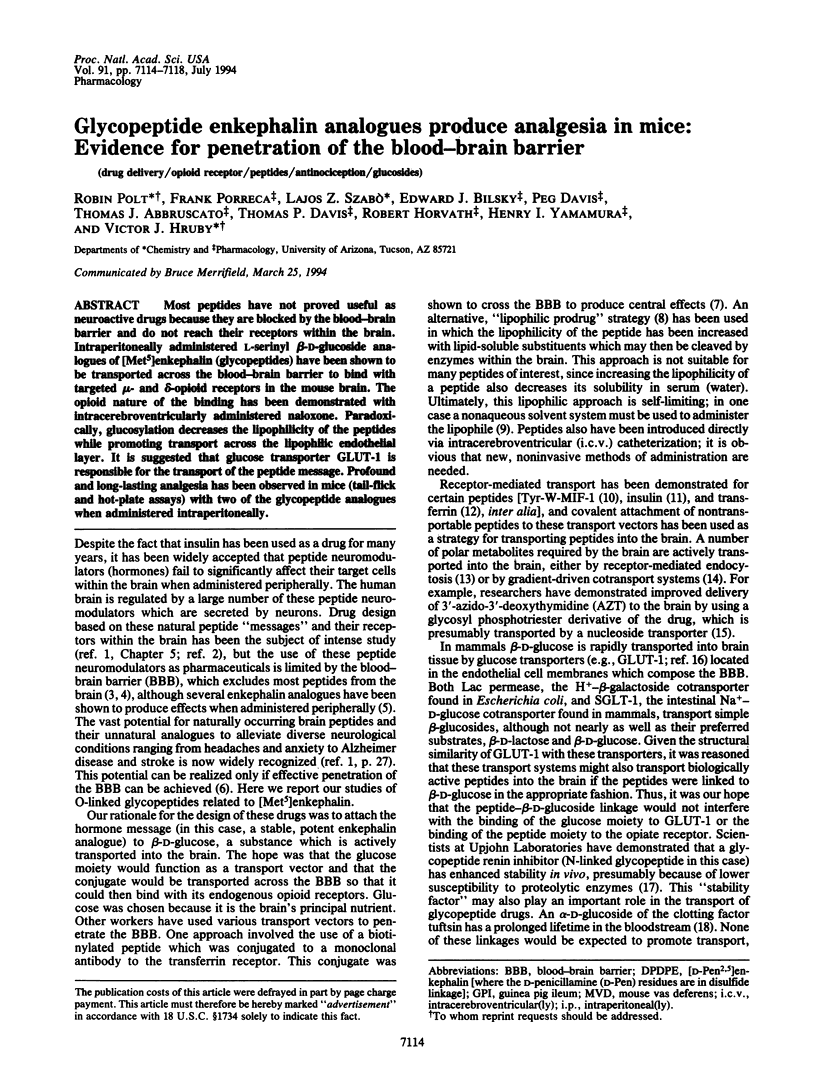
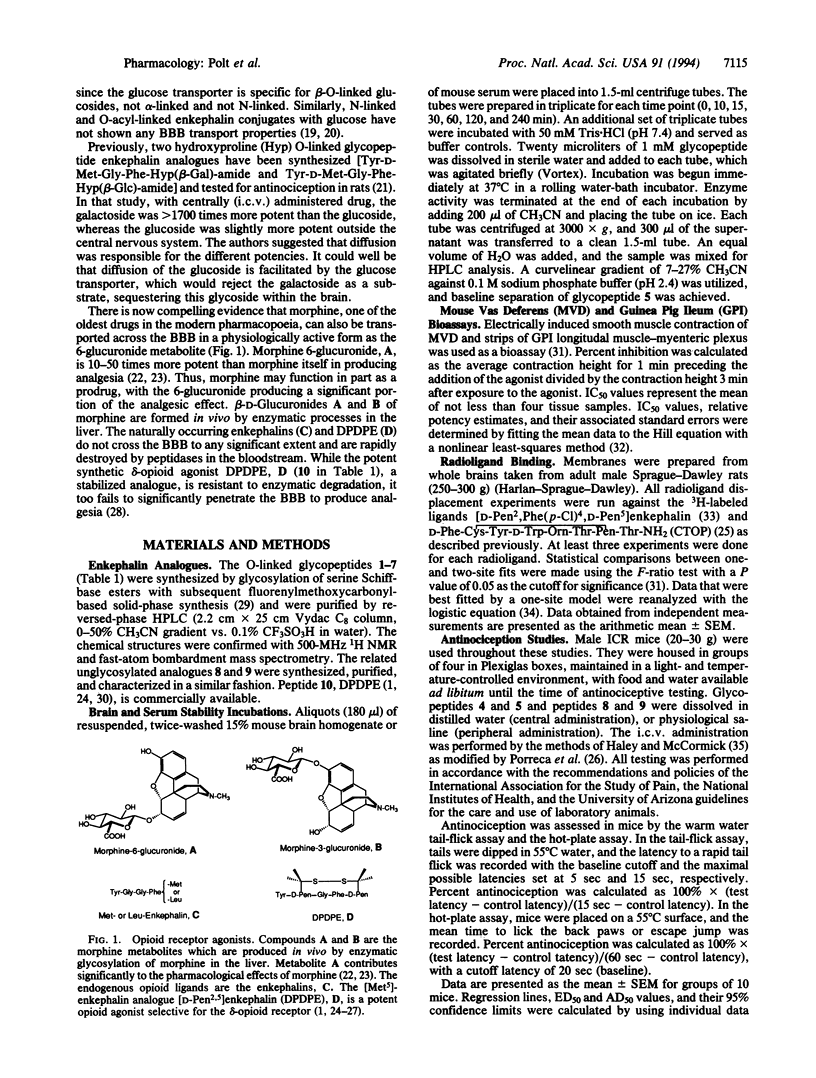
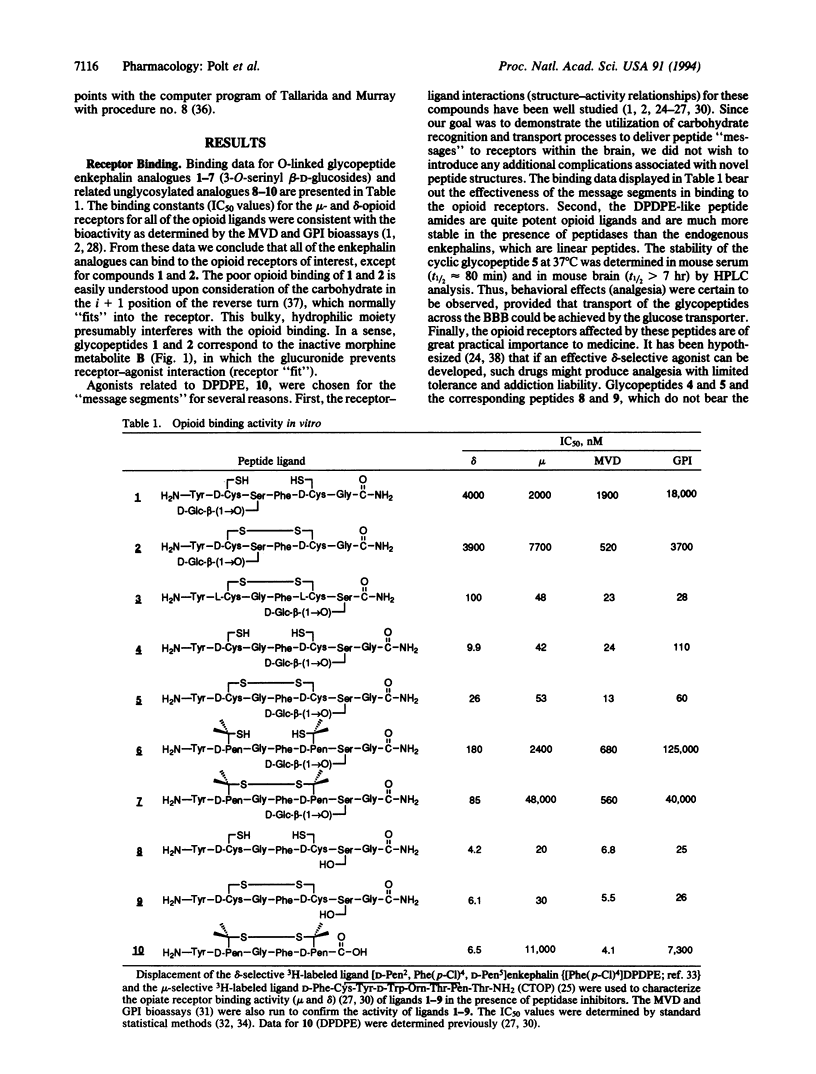
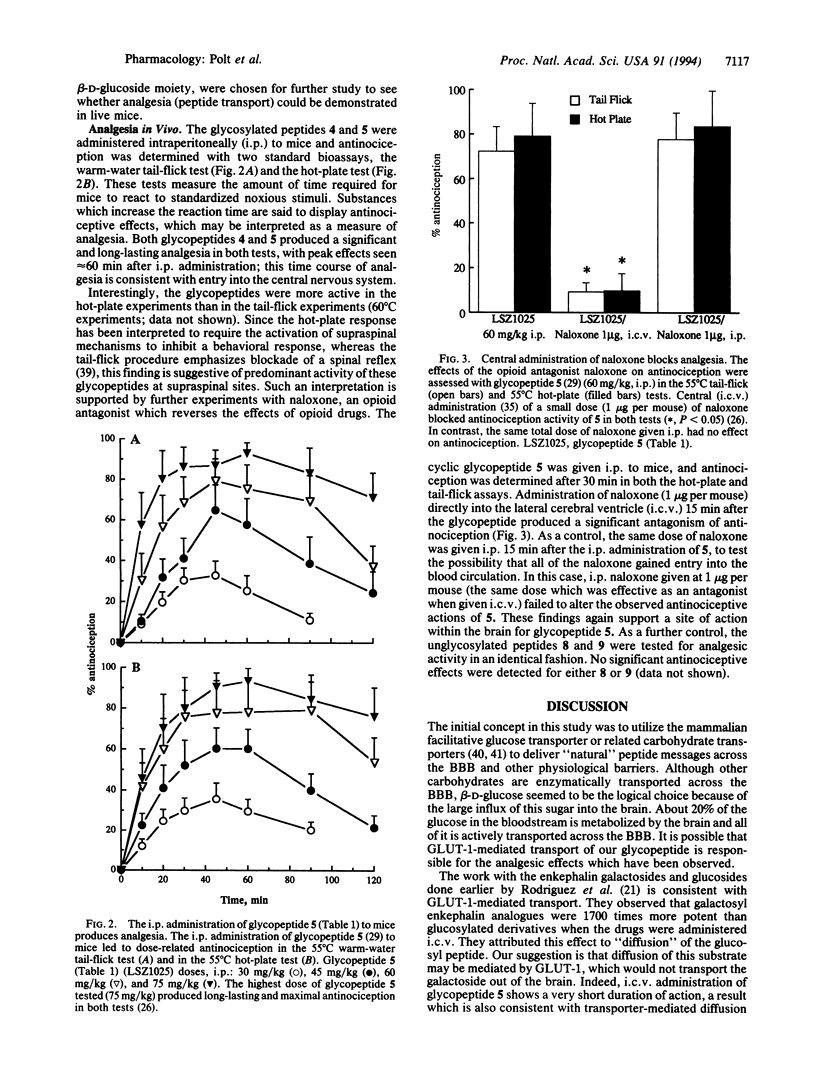
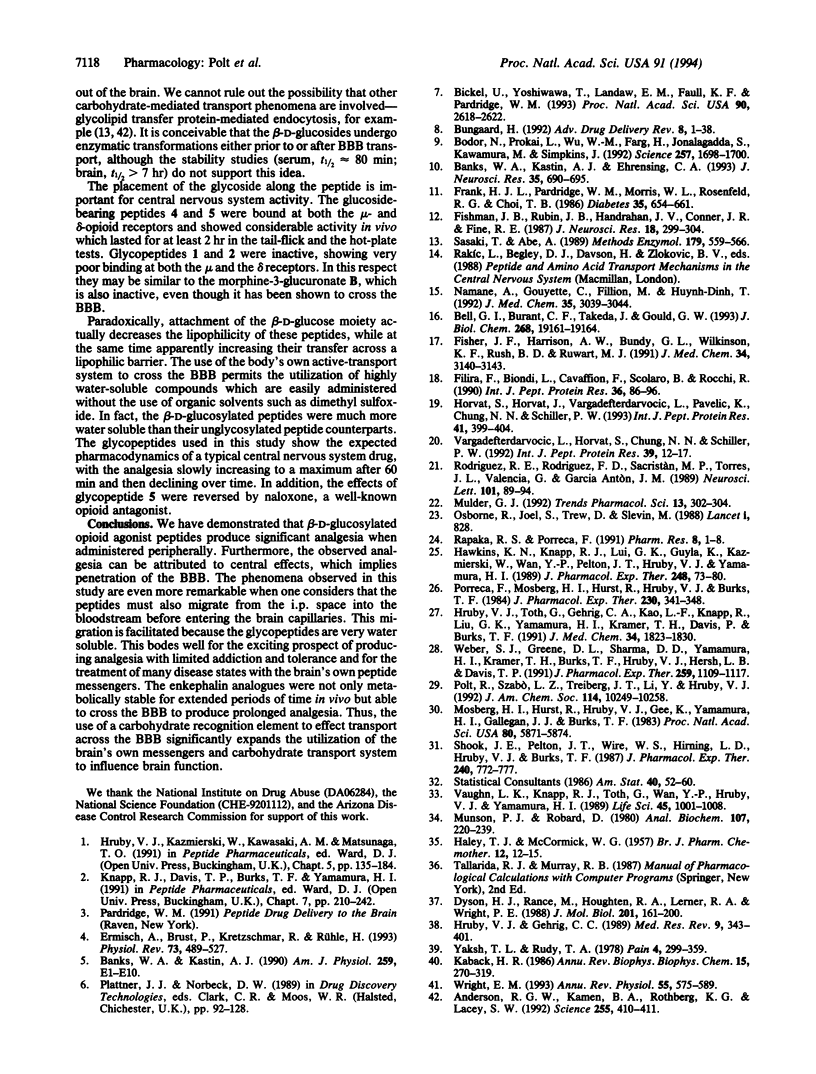
Selected References
These references are in PubMed. This may not be the complete list of references from this article.
- Anderson R. G., Kamen B. A., Rothberg K. G., Lacey S. W. Potocytosis: sequestration and transport of small molecules by caveolae. Science. 1992 Jan 24;255(5043):410–411. doi: 10.1126/science.1310359. [DOI] [PubMed] [Google Scholar]
- Banks W. A., Kastin A. J., Ehrensing C. A. Endogenous peptide Tyr-Pro-Trp-Gly-NH2 (Tyr-W-MIF-1) is transported from the brain to the blood by peptide transport system-1. J Neurosci Res. 1993 Aug 15;35(6):690–695. doi: 10.1002/jnr.490350611. [DOI] [PubMed] [Google Scholar]
- Banks W. A., Kastin A. J. Peptide transport systems for opiates across the blood-brain barrier. Am J Physiol. 1990 Jul;259(1 Pt 1):E1–10. doi: 10.1152/ajpendo.1990.259.1.E1. [DOI] [PubMed] [Google Scholar]
- Bell G. I., Burant C. F., Takeda J., Gould G. W. Structure and function of mammalian facilitative sugar transporters. J Biol Chem. 1993 Sep 15;268(26):19161–19164. [PubMed] [Google Scholar]
- Bickel U., Yoshikawa T., Landaw E. M., Faull K. F., Pardridge W. M. Pharmacologic effects in vivo in brain by vector-mediated peptide drug delivery. Proc Natl Acad Sci U S A. 1993 Apr 1;90(7):2618–2622. doi: 10.1073/pnas.90.7.2618. [DOI] [PMC free article] [PubMed] [Google Scholar]
- Bodor N., Prokai L., Wu W. M., Farag H., Jonalagadda S., Kawamura M., Simpkins J. A strategy for delivering peptides into the central nervous system by sequential metabolism. Science. 1992 Sep 18;257(5077):1698–1700. doi: 10.1126/science.1529356. [DOI] [PubMed] [Google Scholar]
- Dyson H. J., Rance M., Houghten R. A., Lerner R. A., Wright P. E. Folding of immunogenic peptide fragments of proteins in water solution. I. Sequence requirements for the formation of a reverse turn. J Mol Biol. 1988 May 5;201(1):161–200. doi: 10.1016/0022-2836(88)90446-9. [DOI] [PubMed] [Google Scholar]
- Ermisch A., Brust P., Kretzschmar R., Rühle H. J. Peptides and blood-brain barrier transport. Physiol Rev. 1993 Jul;73(3):489–527. doi: 10.1152/physrev.1993.73.3.489. [DOI] [PubMed] [Google Scholar]
- Filira F., Biondi L., Cavaggion F., Scolaro B., Rocchi R. Synthesis of O-glycosylated tuftsins by utilizing threonine derivatives containing an unprotected monosaccharide moiety. Int J Pept Protein Res. 1990 Jul;36(1):86–96. doi: 10.1111/j.1399-3011.1990.tb00086.x. [DOI] [PubMed] [Google Scholar]
- Fisher J. F., Harrison A. W., Bundy G. L., Wilkinson K. F., Rush B. D., Ruwart M. J. Peptide to glycopeptide: glycosylated oligopeptide renin inhibitors with attenuated in vivo clearance properties. J Med Chem. 1991 Oct;34(10):3140–3143. doi: 10.1021/jm00114a026. [DOI] [PubMed] [Google Scholar]
- Fishman J. B., Rubin J. B., Handrahan J. V., Connor J. R., Fine R. E. Receptor-mediated transcytosis of transferrin across the blood-brain barrier. J Neurosci Res. 1987;18(2):299–304. doi: 10.1002/jnr.490180206. [DOI] [PubMed] [Google Scholar]
- Frank H. J., Pardridge W. M., Morris W. L., Rosenfeld R. G., Choi T. B. Binding and internalization of insulin and insulin-like growth factors by isolated brain microvessels. Diabetes. 1986 Jun;35(6):654–661. doi: 10.2337/diab.35.6.654. [DOI] [PubMed] [Google Scholar]
- HALEY T. J., MCCORMICK W. G. Pharmacological effects produced by intracerebral injection of drugs in the conscious mouse. Br J Pharmacol Chemother. 1957 Mar;12(1):12–15. doi: 10.1111/j.1476-5381.1957.tb01354.x. [DOI] [PMC free article] [PubMed] [Google Scholar]
- Hawkins K. N., Knapp R. J., Lui G. K., Gulya K., Kazmierski W., Wan Y. P., Pelton J. T., Hruby V. J., Yamamura H. I. [3H]-[H-D-Phe-Cys-Tyr-D-Trp-Orn-Thr-Pen-Thr-NH2] ([3H]CTOP), a potent and highly selective peptide for mu opioid receptors in rat brain. J Pharmacol Exp Ther. 1989 Jan;248(1):73–80. [PubMed] [Google Scholar]
- Horvat S., Horvat J., Varga-Defterdarović L., Pavelić K., Chung N. N., Schiller P. W. Methionine-enkephalin related glycoconjugates. Synthesis and biological activity. Int J Pept Protein Res. 1993 Apr;41(4):399–404. [PubMed] [Google Scholar]
- Hruby V. J., Gehrig C. A. Recent developments in the design of receptor specific opioid peptides. Med Res Rev. 1989 Jul-Sep;9(3):343–401. doi: 10.1002/med.2610090306. [DOI] [PubMed] [Google Scholar]
- Hruby V. J., Toth G., Gehrig C. A., Kao L. F., Knapp R., Lui G. K., Yamamura H. I., Kramer T. H., Davis P., Burks T. F. Topographically designed analogues of [D-Pen,D-Pen5]enkephalin. J Med Chem. 1991 Jun;34(6):1823–1830. doi: 10.1021/jm00110a010. [DOI] [PubMed] [Google Scholar]
- Kaback H. R. Active transport in Escherichia coli: passage to permease. Annu Rev Biophys Biophys Chem. 1986;15:279–319. doi: 10.1146/annurev.bb.15.060186.001431. [DOI] [PubMed] [Google Scholar]
- Mosberg H. I., Hurst R., Hruby V. J., Gee K., Yamamura H. I., Galligan J. J., Burks T. F. Bis-penicillamine enkephalins possess highly improved specificity toward delta opioid receptors. Proc Natl Acad Sci U S A. 1983 Oct;80(19):5871–5874. doi: 10.1073/pnas.80.19.5871. [DOI] [PMC free article] [PubMed] [Google Scholar]
- Mulder G. J. Pharmacological effects of drug conjugates: is morphine 6-glucuronide an exception? Trends Pharmacol Sci. 1992 Aug;13(8):302–304. doi: 10.1016/0165-6147(92)90095-n. [DOI] [PubMed] [Google Scholar]
- Munson P. J., Rodbard D. Ligand: a versatile computerized approach for characterization of ligand-binding systems. Anal Biochem. 1980 Sep 1;107(1):220–239. doi: 10.1016/0003-2697(80)90515-1. [DOI] [PubMed] [Google Scholar]
- Namane A., Gouyette C., Fillion M. P., Fillion G., Huynh-Dinh T. Improved brain delivery of AZT using a glycosyl phosphotriester prodrug. J Med Chem. 1992 Aug 7;35(16):3039–3044. doi: 10.1021/jm00094a018. [DOI] [PubMed] [Google Scholar]
- Osborne R., Joel S., Trew D., Slevin M. Analgesic activity of morphine-6-glucuronide. Lancet. 1988 Apr 9;1(8589):828–828. doi: 10.1016/s0140-6736(88)91691-1. [DOI] [PubMed] [Google Scholar]
- Porreca F., Mosberg H. I., Hurst R., Hruby V. J., Burks T. F. Roles of mu, delta and kappa opioid receptors in spinal and supraspinal mediation of gastrointestinal transit effects and hot-plate analgesia in the mouse. J Pharmacol Exp Ther. 1984 Aug;230(2):341–348. [PubMed] [Google Scholar]
- Rapaka R. S., Porreca F. Development of delta opioid peptides as nonaddicting analgesics. Pharm Res. 1991 Jan;8(1):1–8. doi: 10.1023/a:1015809702296. [DOI] [PubMed] [Google Scholar]
- Rodriguez R. E., Rodriguez F. D., Sacristán M. P., Torres J. L., Valencia G., Garcia Antón J. M. New glycosylpeptides with high antinociceptive activity. Neurosci Lett. 1989 Jun 5;101(1):89–94. doi: 10.1016/0304-3940(89)90446-1. [DOI] [PubMed] [Google Scholar]
- Sasaki T., Abe A. Glycolipid transfer protein from pig brain. Methods Enzymol. 1989;179:559–566. doi: 10.1016/0076-6879(89)79154-0. [DOI] [PubMed] [Google Scholar]
- Shook J. E., Pelton J. T., Wire W. S., Hirning L. D., Hruby V. J., Burks T. F. Pharmacologic evaluation of a cyclic somatostatin analog with antagonist activity at mu opioid receptors in vitro. J Pharmacol Exp Ther. 1987 Mar;240(3):772–777. [PubMed] [Google Scholar]
- Varga-Defterdarović L., Horvat S., Chung N. N., Schiller P. W. Glycoconjugates of opioid peptides. Synthesis and biological activity of [Leu5]enkephalin related glycoconjugates with amide type of linkage. Int J Pept Protein Res. 1992 Jan;39(1):12–17. [PubMed] [Google Scholar]
- Vaughn L. K., Knapp R. J., Toth G., Wan Y. P., Hruby V. J., Yamamura H. I. A high affinity, highly selective ligand for the delta opioid receptor: [3H]-[D-Pen2, pCl-Phe4, d-Pen5]enkephalin. Life Sci. 1989;45(11):1001–1008. doi: 10.1016/0024-3205(89)90154-9. [DOI] [PubMed] [Google Scholar]
- Weber S. J., Greene D. L., Sharma S. D., Yamamura H. I., Kramer T. H., Burks T. F., Hruby V. J., Hersh L. B., Davis T. P. Distribution and analgesia of [3H][D-Pen2, D-Pen5]enkephalin and two halogenated analogs after intravenous administration. J Pharmacol Exp Ther. 1991 Dec;259(3):1109–1117. [PubMed] [Google Scholar]
- Wright E. M. The intestinal Na+/glucose cotransporter. Annu Rev Physiol. 1993;55:575–589. doi: 10.1146/annurev.ph.55.030193.003043. [DOI] [PubMed] [Google Scholar]
- Yaksh T. L., Rudy T. A. Narcotic analgestics: CNS sites and mechanisms of action as revealed by intracerebral injection techniques. Pain. 1978 Apr;4(4):299–359. doi: 10.1016/0304-3959(77)90145-2. [DOI] [PubMed] [Google Scholar]


